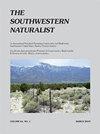A PIGEON'S EYE VIEW OF A UNIVERSITY CAMPUS
IF 0.2
4区 环境科学与生态学
Q4 Agricultural and Biological Sciences
引用次数: 0
Abstract
Abstract Increasing urbanization over the last century has resulted in a greater abundance of invasive species. Invasive feral pigeons (Columba livia) damage critical urban infrastructure and pose risks to human health. Universities, including Texas Tech University (TTU), located in Lubbock, Texas, have difficulty decreasing adverse effects caused by pigeons. Assessing reliable estimates of population demographics is an important first step to understanding and managing damaging pigeon populations. Our goal was to estimate pigeon abundances at TTU and understand the underlying mechanisms that facilitated pigeon persistence on campus. We surveyed 23 independent locations from March to April 2017 to estimate pigeon abundance across the entire campus. Separately, we also examined pigeon densities on two campus buildings from March to December 2017 to assess and quantify variation in pigeon detection probabilities and abundance both during the diurnal period and among calendar seasons. Our estimates suggested campus abundance was comparable to other urban areas (1,584.4 pigeons/km2, SE = 43.58, 95% CI = ±1,969). Our results indicated hot spots (i.e., high pigeon abundances) existed on campus; for example, we estimated ∼2,819 pigeons (SE = 76, 95% CI = ±138) on a single building on campus during our surveys. Enumeration of pigeon abundance on two campus buildings (mean = 326, SE = 16, 95% CI = ±11) indicated abundance was greatest in the fall and during the morning hours, and peak abundance occurred shortly after 0700 h and declined during the day. Our results suggested pigeons were abundant on campus due to structure and composition of buildings that facilitated nesting and loafing spots that likely maximized efficiency and effectiveness of thermal regulation as well as direct access to water during the study period. In general, pigeons clustered on two buildings on campus and our findings suggested success of population-control measures may be maximized if they are implemented around these buildings.大学校园的鸟瞰图
摘要上个世纪以来,城市化程度的提高导致了入侵物种的丰富。入侵的野鸽(Columba livia)破坏了重要的城市基础设施,并对人类健康构成风险。包括得克萨斯理工大学(TTU)在内的大学都很难减少鸽子造成的不良影响。评估种群人口统计的可靠估计是了解和管理破坏性鸽子种群的重要第一步。我们的目标是估计TTU鸽子的丰度,并了解促进鸽子在校园中持续存在的潜在机制。2017年3月至4月,我们调查了23个独立地点,以估计整个校园的鸽子数量。另外,我们还调查了2017年3月至12月两栋校园建筑的鸽子密度,以评估和量化白天和日历季节鸽子检测概率和数量的变化。我们的估计表明,校园的数量与其他城市地区相当(1584.4只鸽子/平方公里,SE=43.58,95%CI=±1969)。我们的研究结果表明,校园内存在热点(即鸽子数量高);例如,在我们的调查中,我们估计校园内一栋建筑上有约2819只鸽子(SE=76,95%CI=±138)。对两栋校园建筑鸽子丰度的计数(平均值=326,SE=16,95%CI=±11)表明,鸽子丰度在秋季和早晨最大,峰值出现在0700小时后不久,并在白天下降。我们的研究结果表明,在研究期间,由于建筑物的结构和组成有助于筑巢和觅食,可能会最大限度地提高热调节的效率和有效性,以及直接取水,因此校园里鸽子数量众多。总的来说,鸽子聚集在校园的两栋建筑上,我们的研究结果表明,如果在这些建筑周围实施人口控制措施,可能会最大限度地成功。
本文章由计算机程序翻译,如有差异,请以英文原文为准。
求助全文
约1分钟内获得全文
求助全文
来源期刊

Southwestern Naturalist
环境科学-生态学
CiteScore
0.50
自引率
50.00%
发文量
47
审稿时长
18-36 weeks
期刊介绍:
The Southwestern Naturalist (a publication of the Southwestern Association of Naturalists since 1953) is an international journal (published quarterly) that reports original and significant research in any field of natural history. This journal promotes the study of plants and animals (living and fossil) in the multinational region that includes the southwestern United States, Mexico, and Central America. Appropriate submission of manuscripts may come from studies conducted in the countries of focus or in regions outside this area that report significant findings relating to biota occurring in the southwestern United States, Mexico, and Central America. Publication is in English, and manuscripts may be feature articles or notes. Feature articles communicate results of completed scientific investigations, while notes are reserved for short communications (e.g., behavioral observations, range extensions, and other important findings that do not in themselves constitute a comprehensive study). All manuscripts (feature articles and notes) require an abstract in both English and Spanish.
 求助内容:
求助内容: 应助结果提醒方式:
应助结果提醒方式:


